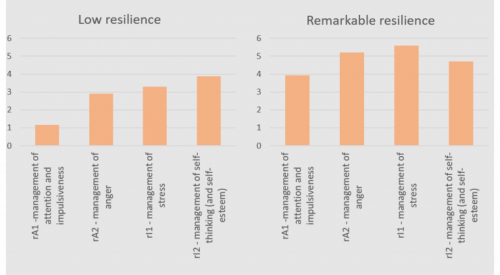We connect mindfulness, neuroscience and resilience. Also, meditation, neuroscience and resilience. The practice of mindfulness has positive effects on the brain. One of them is that resilience improves by practicing mindfulness and meditation. We introduce the resilience indices of NeuroQuotient®.The book ‘Altered Traits. Science Reveals how Meditation Changes your Mind, Brain and Body by Daniel Goleman and Richard J. Davidson was very helpful to explain the connection.
Introduction.
NeuroQuotient® is a model and a tool that helps us understand the neuroscience of behavior. In this case it will be useful to see the relationship between mindfulness, neuroscience and resilience (and meditation, neuroscience and resilience). Specifically to see the effect that mindfulness practice has on the brain and how it favors resilience.
Behind our behavior there are patterns that are sustained by brain structures (centers and neuronal pathways). In another post we explain how these patterns are created and reinforced through the principle of Donald Hebb.
When the patterns are very marked, they can become ‘behavior’ traits, (even personality traits) that are very characteristic of each person.
Daniel Goleman and Richard J. Davidson, in their book:‘Altered Traits. Science Reveals how Meditation Changes your Mind, Brain and Body’, they tell us that the practice of meditation helps us modify some of these ‘traits’.
From NeuroQuotient®, we believe that, the practice of mindfulness and meditation helps us, indeed, to modify brain patterns. In addition, we are convinced that the main ‘traits’ that are modified contribute to improved resilience. NeuroQuotient® allows us to measure progress in these traits through, as we will see, the resilience indices.
We will connect, then, mindfulness, neuroscience and resilience, through NeuroQuotient® and its resilience indices. The ideas of the book by Goleman and Davidson will be useful to confirm how is this connection between mindfulness, neuroscience and resilience.
Let’s start by briefly describing what we mean by some concepts such as resilience, meditation, mindfulness and neuroscience. And a little more about NeuroQuotient®.
Resilience
Resilience at work means: pressure tolerance, fatigue resistance, ability to concentrate, etc. It has more to do with the person himself than with the events and inputs of the environment.
Resilience refers, in general, to the ability of human beings to adapt successfully to adverse situations. But, at the day-to-day level at work we don’t need to look for great adversities. We can talk about ‘pressure tolerance’, ‘fatigue resistance’, ‘ability to stay focused and keeping the attention span, etc. Additionally, high resilience corresponds to a good level of self-leadership, of self-management.
In all these cases, it is the person himself, rather than the signals and stressors of the environment, that has the greatest influence. It’s about how you perceive, react and feel in different situations.
Meditation, mindfulness and neuroscience.
With meditation we refer to the ancient Eastern tradition. With Mindfulness (full awareness of the present moment) we refer to the practical adaptation of meditation to the Western world, and with its application on a daily basis and at work.
From now on, although Goleman and Davidson refer more to meditation, we will remain with mindfulness and neuroscience. Above all, for the practical vocation that mindfulness has. In today’s fast and demanding world, few people have time for a deep practice of meditation. However, it is accessible to incorporate informal mindfulness exercises on a day-to-day basis that result in improved resilience.
So far, we have talked about mindfulness and neuroscience, and meditation and neuroscience, interchangeably. From here, we will stay with mindfulness, neuroscience and resilience.
A little more about NeuroQuotient®
As we have said, in NeuroQuotient® we deal with the behavior and the brain patterns on which it is based. We call them neuro behaviors.
With NeuroQuotient®, after answering a questionnaire, we have a snapshot of a time in the person’s life (current state) regarding their most frequent neuro behaviors. We differentiate between efficient neuro behaviors (in color in the graph) and limiting neuro behaviors (in gray). The effective ones bring satisfaction to the person. The limiters do not provide good emotional results.
The higher the efficiencies and the lower the limitations are, the higher the level of self-leadership. We measure the level of self-leadership with the NQ index.
The NQ index correlates very well with the scale Self-Directedness of the TCI-R model of Dr. Robert Cloninger.

With mindfulness practice, neuro behaviors are modified, and people’s satisfaction and resilience improve. The connection between mindfulness, neuroscience and resilience is actual and effective.
From the beginning we observed that development efforts were worth it. The most evolved people, with better self-leadership, told us: ‘Some time ago (one, two, three, years) I would not have answered in the same way; my limitations would have been much higher.
And this answer was independent of the development method used. From simple awareness, or coaching, or psychotherapy, or meditation, etc. Meditation and mindfulness were one of the paths. The most effective, we believe.
In short, with the development process, there had been a change in the neuro behaviors, in the brain patterns, of the person.
And, of course, when these new behavior patterns persist beyond the old ones that limited the person’s satisfaction, we can talk about modified traits, as a result of the development process.
NeuroQuotient® Resilience Indices
The dimensions of resilience in NeuroQuotient® are the reverse of the limitations. Low limitation means a high dimension of resilience.
And how do we connect NeuroQuotient® with resilience?
In a very simple way. When the limitations in NeuroQuotient® are low, the ability to respond to adverse situations (or perceived as such) is better. Also, very important! Greater is the ability not to amplify the adverse environmental signals. That is, with low limitations, the greater the resilience.
Hence the reverse of the limitations are the dimensions of resilience. We named them this way:
rA1 – management of attention and impulsiveness.
rA2 – management of anger (and empathy).
rI1 – management of stress.
rI2 – management of self-thinking (and self-esteem).
In Fig 2 are the graphs for two real cases with different levels of resilience according to NeuroQuotient®.
Let’s describe these resilience indices. At same time we will refer to some of the ´Altered Traits´ the result of the practice of meditation and mindfulness, as Goleman and Davidson tell us. In this way, we can connect mindfulness, neuroscience and resilience.

rA1 – management of attention and impulsiveness.
Modified traits related to improved concentration and attention span, and with the resilience dimension rA1.
Some of the altered traits, according to Goleman and Davidson, refer to a better attention, to a greater focus, to decrease the tendency of the mind to wander, to control the response to external distraction signals (blinks), to potentiation of working memory, etc.
That is, they are related to the resilience dimension rA1. Although in rA1 we also include other neuro behaviors. Brain patterns that have to do with low impulsivity, with not being carried away by the illusion of the moment and / or by the search for immediate reward. Also, with not creating one-self unrealistic expectations.
In general, it is an optimal management of the reward system in its prefrontal (attention, concentration) and limbic (motivation) pathways. We believe that the practice of mindfulness is positive for both aspects. A key element in the relationship mindfulness, neuroscience and resilience.
When dealing about attention and focus, Goleman and Davidson talk about multitasking. For them the multitasking brain does not exist, but it is connecting, and disconnecting quickly from one task to another. With this premise, it is obvious that people with a tendency to multitasking are more easily distracted.
Attention is essential in all functions of the prefrontal cortex, for this reason, mindfulness also improves working memory.
rI1- management of stress and rA2 – management of anger (and empathy).
Modified traits related to reduced activation of the amygdala (threat system, fear) and stress. Also, with the ability to manage fear and the amygdala with the PFC (prefrontal cortex). Resilience dimensions rI1 and rI2.
Other modified features, according to Goleman and Davidson have to do with a lower reactivity of the amygdala (threat system center in the brain) to stress and a greater ability to manage it from the PFC (prefrontal cortex).
From there we are going to the resilience dimensions rA2 and rI1. Behind them is, indeed, the system of threats or fear, with the amygdala as the fundamental brain center. After the amygdala of an animal is activated, in response to a threat of the environment, the stress (adrenaline) is switch on (in the version ‘fight’ or ‘flight’).
But, humans, we can amplify these signals. We can even imagine them only with our thoughts. But, also, we can stop them with the same PFC (prefrontal cortex). When we dealt about stress we saw the prefrontal connection with the intercalated GABA cells (CIT) that calm down the amygdala.
If we are able to manage our internal stress, and not increase it by worrying, the resilience index rI1 will be high.
If we manage the externalization of stress, curbing our anger and aggressiveness, the rA2 resilience index will also be high.
In addition, with respect to rA2, there is another modified feature. From meditation and mindfulness, there is a better connectivity of the empathy circuit.
We are more prepared to feel the negative effect on others when we expel our stress towards them. In addition, in this case it is the oxytocin that calms the amygdala by acting on the interspersed GABA neurons.
rI2 – management of self-thinking (and self-esteem).
With meditation and mindfulness, the default network related to rumination and depression, and the tendency to think negative about oneself, also becomes less active. The resilience dimension rI2 is increased.
Finally, but very important, is the rI2 resilience dimension.
When it is low, it includes a high tendency to ‘rumination’. To stay blocked by turning to negative thoughts about ourselves and to blame ourselves.
This neuro behavior can be a symptom of major depression. In a depressive state there is absence of motivation, energy is very low and self-esteem is negatively affected. Resilience is zero. The high rI2 dimension means the opposite: motivation, energy and self-esteem.
It is well described that the circuit default network ’brain circuit is involved in rumination.
Well, Goleman and Davidson, tell us that with meditation the dorsolateral prefrontal connection that inhibits the default network is reinforced. Another key relationship between mindfulness, neuroscience and resilience.
Persist in practice!
With meditation and mindfulness, the altered traits appear soon, but it is necessary to persist in practice so that they consolidate and endure. With NeuroQuotient® we measure progress!
Finally, keep in mind that, as Goleman and Davidson say, the altered traits arise with little need for practice, but it is necessary to persist in it to last.
It is necessary to consolidate the new neuronal pathways to prevail over the previous ones. This tells us the Hebb principle we quoted at the beginning. Simple, but very important to understand the connection between mindfulness, neuroscience and resilience.
It is necessary to persist in practicing mindfulness. If we abandon, the previous patterns will reappear as stronger than the new ones created, and reinforced, with the practice of mindfulness.
On the other hand, with NeuroQuotient® we can track to measure progress in resilience indices.




